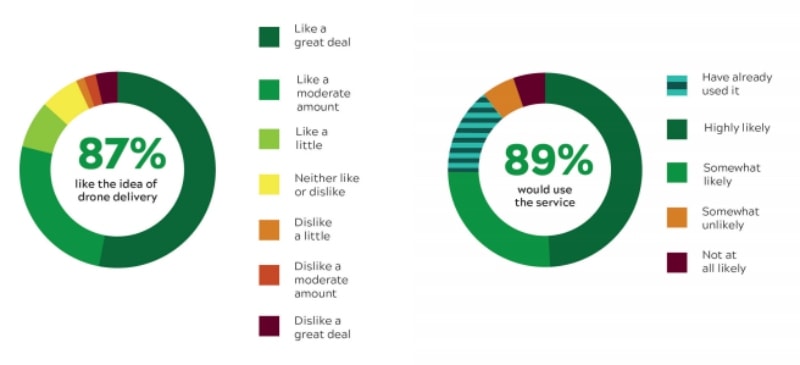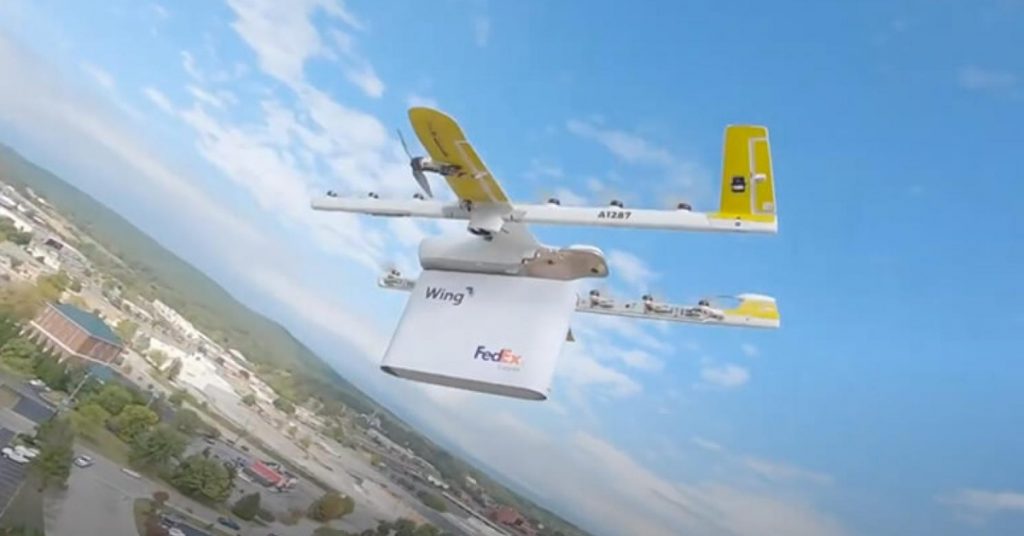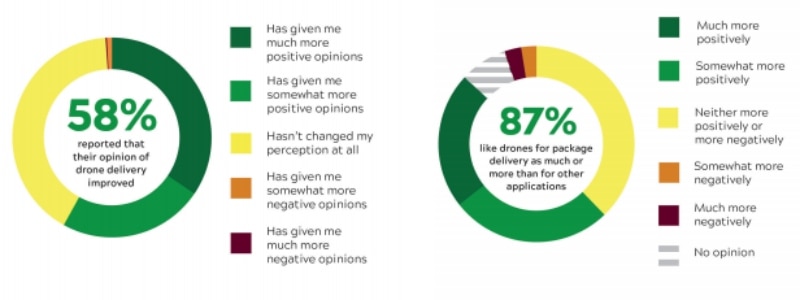New Study Indicates that Drone Delivery Programs Could Help Boost Public Perception of Drones
BY Zacc Dukowitz
29 April 2021A new study reveals that people living in Christiansburg, VA have a very good impression of drone delivery.
87% of respondents in the study said they like the idea of drone delivery and 89% said they would use drone delivery.

Image credit: MAAP
The study was conducted by the Virginia Tech Mid-Atlantic Aviation Partnership (MAAP)—a partner in the FAA’s BEYOND program—and Lee Vinsel, an assistant professor at Virginia Tech.
Christiansburg is the site of Wing’s first drone delivery program, which is also the first regular drone delivery program ever to exist in the U.S.
MAAP has a close connection to that delivery program, having served as the drone test site where Wing went through the rigorous safety demonstrations that the FAA required in order to grant the company permission to launch the program.
That testing was conducted under the UAS IPP (UAS Integration Pilot Program), of which both MAAP and Wing were partners. When the IPP was phased into the BEYOND program last October, both of them stayed on as partners.
Does Drone Delivery Make People Like Drones More?
It sure looks that way.
The findings from the MAAP study are significant because they deviate significantly from other studies that have looked at the public perception of drones, which have found that only about half to a third of people like or would support drones and drone deliveries:
- A 2019 study from the Hawthorne group conducted in 2019 found that only 51% of Americans would support neighborhood drone delivery
- A 2019 study from PwC found that only 31% of the public “feel positive” about drone technology
- A 2020 study from the Consumer Technology Association found that only 49% of consumers rate drone (or other autonomous) delivery as “somewhat or very” favorable

Photo credit: Wing
So why is favorability for drone delivery so high in Christiansburg?
An obvious hypothesis is that they’ve become familiar to the residents. To those unfamiliar with the current drone industry, the word drone could still evoke a weapon used in warfare or a means of spying on your neighbor—not something that was useful to you or a common part of your life.
But in Christiansburg, drone delivery has become commonplace. And the sheer repetition of seeing drones in the sky and receiving deliveries from them has probably played a role in the high marks the public gives them in the study.
What about COVID-19?
A study like this wouldn’t be worth much if it didn’t try to account for the fact that the last year has been a unique time for everyone, and that drone delivery has had a special role to play in these times of social distancing.
To address the unique conditions created by COVID-19 in the study, researchers asked respondents whether the pandemic had improved their opinion of drone delivery. 58% said it had.

Image credit: MAAP
In the same study mentioned above, the Consumer Technology Association asked the same question of the general population—people who had not actually had the option to use drone delivery—and only 26% of its respondents viewed autonomous delivery technologies “more favorably than before the coronavirus healthcare crisis.”
So the positive outlook in Christiansburg probably can’t be attributed solely to the pandemic. But it does seem that access to drone delivery and the demand for it caused by quarantine has combined there to create a favorable spike in public perception, as compared to the general public.
About the Study
The MAAP study was conducted in the Fall of 2020, well into the quarantines caused by the pandemic.
The town of Christiansburg has about 22,000 residents. The study got responses from 821 of them, or about 4% of the population. (To participate, respondents had to live within a certain geographical area in order to simplify the requirements of the study.)
One of the most striking findings from the survey is the one we opened this article with—that 89% of the respondents had either already used drone delivery or were likely to do so if it were made available to them.
Having 89% of any group of people feel the same way about something is a startlingly high amount, regardless of the topic.
But this positive perception wasn’t created by accident. A key aspect to the success of the drone delivery program in Christiansburg is that Wing and MAAP involved the community early on in the planning process.
Rather than showing up and announcing the launch of a drone delivery program, they worked to incorporate community perspectives, which was one of the core objectives of the IPP program (and a continued objective of the BEYOND program).
In short, the study’s findings can be seen as a drone delivery success story. Through careful planning and thoughtful execution, Wing seems to have made a good impression and helped with the overall perception of drones among people who may not have liked them, or even thought much about them, before the program started.
And public perception matters, especially when you’re trying to roll out new initiatives like drone delivery.
Public attitudes towards drone delivery will significantly influence the ultimate success of these programs in communities.
– MAAP Study “Perspectives on Drone Delivery”
After all, if people don’t like the drones, they’re probably not going to be making very many orders.
Happy to hear about the findings of the MAAP study? Share your thoughts in this post on the UAV Coach community forum.


